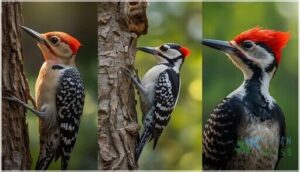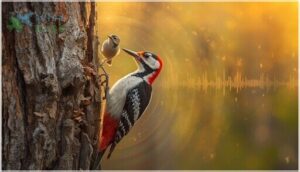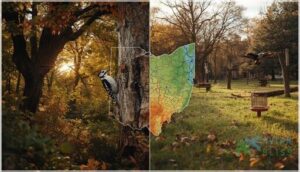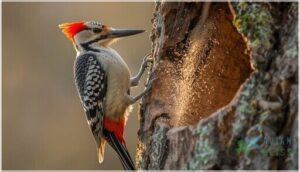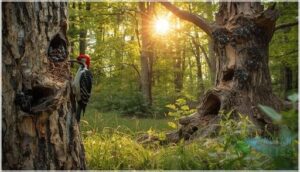This site is supported by our readers. We may earn a commission, at no cost to you, if you purchase through links.
You’re sitting on your porch when a flash of red and black catches your eye—a woodpecker hammering away at your oak tree with mechanical precision. Ohio hosts eight distinct woodpecker species, from the sparrow-sized Downy to the crow-sized Pileated, each with its own quirks and preferred haunts.
But here’s the catch: some are disappearing fast. Red-headed Woodpeckers have lost 75% of their population since 1970, while others adapt surprisingly well to backyards and city parks.
Whether you’re trying to identify the bird decimating your deck or hoping to spot a rare migrant along Lake Erie, knowing which woodpeckers call Ohio home—and when—turns casual observation into genuine discovery.
Table Of Contents
- Key Takeaways
- Woodpecker Species Found in Ohio
- Identifying Ohio’s Woodpeckers
- Habitats and Distribution Across Ohio
- Woodpecker Behavior and Adaptations
- Conservation and Importance in Ohio
- Frequently Asked Questions (FAQs)
- How many types of Woodpeckers are there in Ohio?
- Where do woodpeckers live in Ohio?
- Are there red headed woodpeckers in Ohio?
- What is the largest woodpecker in Ohio?
- Are woodpeckers endangered in Ohio?
- Are black backed woodpeckers common in Ohio?
- What are the most colorful woodpeckers in Ohio?
- Is a Hairy Woodpecker common in Ohio?
- Where can I find a pileated woodpecker in Ohio?
- Are some woodpeckers migratory in Ohio?
- Conclusion
Key Takeaways
- Ohio hosts eight woodpecker species year-round or seasonally, but Red-headed Woodpeckers have crashed 75% since 1970 due to habitat loss—making them critically threatened despite once being common statewide.
- You can identify woodpeckers fast by checking bill length first (short versus long chisel), then scanning for red head patches on males, distinctive drumming speeds (15 beats/second for Pileated versus slower bursts for Downies), and calls ranging from sharp “piks” to rolling “churrs.”
- These birds aren’t just pretty—they’re ecosystem engineers that devour 5,000 wood-boring larvae yearly, create nesting cavities for 24+ other species, and save forests thousands in pesticide costs while boosting biodiversity by 30-40%.
- You don’t need wilderness to find woodpeckers—Downies show up at 78% of suburban feeders and even Pileated giants follow riparian corridors through metro areas, especially where dead trees and native oaks remain standing.
Woodpecker Species Found in Ohio
Ohio’s woodpeckers break free from the one-size-fits-all stereotype—you’ll find everything from tiny backyard regulars to massive, crow-sized birds that make you stop and stare. Some stick around all year, while others just pass through on their seasonal adventures.
Let’s look at which species you can expect to see, starting with the reliable year-round residents, then the seasonal visitors, and finally those rare gems that show up when you least expect them.
Year-Round Resident Species
Five woodpeckers in Ohio call the state home all year, giving you plenty of chances to spot them. These resident species have carved out their niches across Ohio’s forests and backyards:
- Downy Woodpecker — the smallest and most widespread, found in all counties
- Hairy Woodpecker — larger cousin, thriving in over 70% of urban areas
- Red-bellied Woodpecker — striking coloration, nests in dense vegetation
- Red-headed Woodpecker — declining but still present in western regions
- Pileated Woodpecker — massive and distinctive, preferring southern Ohio’s mature forests
Population trends show most resident species remain stable, though habitat preferences vary widely. The Downy Woodpecker’s adaptability to different environments, such as urban woodpecker habitats, contributes to its widespread presence in Ohio.
Migratory and Seasonal Visitors
Unlike the permanent residents, you’ll catch three woodpeckers only during specific seasons—and their migration patterns tell a remarkable story. The Yellow-bellied Sapsucker and Northern Flicker are your main seasonal visitors, with Red-headed Woodpeckers showing up irregularly depending on food availability. These birds often rely on tree sap sources for nutrition during their migrations.
Here’s when to watch Ohio’s skies for these traveling drummers:
| Species | Spring Peak | Fall Peak |
|---|---|---|
| Yellow-bellied Sapsucker | Late April | September–Early October |
| Northern Flicker | Mid-April | September–October |
| Red-headed Woodpecker | May (Lake Erie) | August (variable) |
Lake Erie acts as a highway for these avian travelers, with up to 5 million migratory birds detected on peak nights. Northern Flickers show partial migration—some stick around southern Ohio while others head south. Climate effects are shifting these traditional woodpecker routes northward, changing when and where you’ll spot these seasonal woodpecker species during their stopovers.
Rare and Uncommon Woodpeckers
Beyond seasonal visitors, four rare woodpecker species occasionally appear in Ohio—though you’ll need serious luck to spot them. The Red-naped Sapsucker turns up during migration near major flyways, while Black-backed Woodpeckers show up after forest fires.
Most sobering are extinction risks facing two species:
- Red-cockaded Woodpecker – Endangered, with scarce undocumented sightings in Ohio
- Ivory-billed Woodpecker – Likely extinct; last Ohio records from early 1900s
- Red-headed Woodpecker – 75% population crash since 1970, now rare statewide
Identifying Ohio’s Woodpeckers
Learning to tell Ohio’s woodpeckers apart doesn’t have to be a guessing game. Once you know what to look for—size, color patterns, sounds—you can ID most species in seconds.
Here’s what separates one woodpecker from another in the field.
Key Physical Characteristics
You’ll spot Ohio’s woodpeckers by their striking plumage patterns and specialized physical adaptations. Distinctive head markings—red crests, caps, or patches that vary by species—are key identifiers. Beak shapes range from the downy’s short bill to the pileated’s powerful chisel.
Feather patterns show bold black-and-white combinations, while tail features provide that essential “kickstand” for vertical climbing. These plumage colors aren’t just beautiful—they’re your roadmap to woodpecker species identification.
Distinguishing Field Marks
When you’re face-to-face with a woodpecker, nail down the ID by checking bill length first—downy’s stubby versus hairy’s long chisel tells the whole story. Look for those red head patches (males only!), then scan wing spots and belly hues.
The pileated’s triangular crest breaks all the rules, while flickers show off that sneaky mustache stripe.
Woodpecker Sounds and Calls
Often, you’ll hear an Ohio woodpecker before you spot it—distinctive acoustic signals help seal your ID when field marks stay hidden. Downy woodpeckers fire off that sharp “pik” year-round, while red-bellied birds deliver a rolling “churr” that carries over 100 meters through the forest.
- Drumming speed varies wildly: pileated woodpeckers hammer at 15 beats per second, while downies use slower bursts
- Sound pressure hits 99 decibels at contact—louder than your lawn mower
- Call frequencies range from 1,200 to over 2,400 Hz, helping species avoid acoustic interference in overlapping territories
Habitats and Distribution Across Ohio
Knowing where to find Ohio’s woodpeckers can make all the difference when you’re out looking for them. These birds don’t scatter randomly across the state—they pick specific habitats based on what they need to survive.
Let’s break down the forest types they prefer, where you’ll spot them in towns and cities, and how their movements shift with the seasons.
Preferred Forest Types and Regions
Most Woodpeckers in Ohio thrive in mature deciduous forests rich in deadwood availability—that’s where 90% of their foraging happens. Forest ecology varies statewide: southern regions boast the highest diversity, while habitat fragmentation threatens specialist species. Woodland management efforts are turning the tide, though.
Tree species composition matters—oaks and hickories create ideal conditions, while habitat loss continues shrinking woodland ecosystems across central Ohio.
| Forest Type | Key Woodpecker Species |
|---|---|
| Oak-Hickory Woods | Red-Headed, Pileated |
| Mixed Hardwood Stands | Hairy, Downy, Red-Bellied |
| Pine Forests (Eastern OH) | Hairy, Red-Bellied |
| Riparian Corridors | Northern Flicker, Yellow-Bellied Sapsucker |
Urban and Suburban Sightings
You don’t need wilderness to find woodpeckers in Ohio—your backyard might already host them. Urban habitats and suburban trees attract several species year-round, especially near city parks with mature canopy. Backyard birding reveals surprising diversity:
- Downy Woodpeckers dominate suburban feeders (78% of sightings)
- Red-bellied Woodpeckers appear at 62% of urban survey sites
- Pileated Woodpeckers follow riparian corridors through metros
- Dead trees boost nesting rates by 22% in parks
Woodpecker identification gets easier with regular backyard wildlife observation.
Seasonal Movement and Migration Patterns
Think woodpeckers in Ohio are homebodies? Most stick around, but migration patterns reveal surprises. Red-headed Woodpeckers shift south when food availability drops—sometimes traveling 111–218 km. Climate effects and habitat fragmentation reshape traditional migration routes, while bird tracking data shows Yellow-bellied Sapsuckers peak through Ohio between late September and October.
| Species | Movement Type | Peak Timing |
|---|---|---|
| Red-headed | Facultative (food-dependent) | Sept 1–10 departure |
| Yellow-bellied Sapsucker | Full migrant | Sept 29–Oct 10 fall |
| Northern Flicker | Partial resident | Apr 17–27 spring |
| Downy/Hairy | Year-round resident | Minimal movement |
| Pileated | Year-round resident | Local only |
Understanding avian migration patterns helps you predict when migratory birds arrive at your feeders.
Woodpecker Behavior and Adaptations
Woodpeckers aren’t just pretty birds tapping on trees—they’re basically nature’s engineers with some wild built-in tools. Everything about them, from their tongues to their toes, is designed for one thing: making a living on vertical surfaces.
Let’s break down how these birds feed, raise their families, and pull off those remarkable physical feats.
Foraging and Feeding Habits
You’ll spot these birds using different foraging strategies depending on what’s for dinner. Their insect diet includes beetle larvae and carpenter ants, which they chisel from tree bark.
Red-bellied species mix it up with 50% fruits and nuts. Yellow-bellied Sapsuckers drill wells for tree sap.
Some cache food in crevices for winter, while feeding rates spike during pest outbreaks—nature’s pest control at work.
Nesting and Breeding Behavior
Beyond finding food, cavity nesters like these show fascinating breeding behaviors. Nest site selection happens in large dead trees—prime real estate for nesting sites. Downy woodpeckers prefer downward-angling limbs, while red-bellied species choose spots with thick ground cover.
Breeding seasons run January through July depending on species, with clutch sizes of 2–8 eggs. Both parents share parental care duties equally during nest construction and feeding.
Physical Adaptations for Drumming and Climbing
So how do woodpeckers hammer away without scrambling their brains? It’s all about cranial structure and shock absorption—their skulls can handle up to 1,000 g-force impacts. The hyoid apparatus wraps around their skull, letting their tongue reach deep into wood while cushioning each blow.
Zygodactyl toes (two forward, two back) grip bark like climbing spikes, while stiff tail feathers prop them up.
Conservation and Importance in Ohio
Ohio’s woodpeckers aren’t just cool birds to watch—they’re working hard to keep forests healthy and ecosystems balanced. But some species are struggling, and understanding what they’re up against helps us protect them.
Let’s look at their current status, why they matter, and what you can do to help these remarkable birds thrive.
Population Trends and Threats
Sadly, Ohio’s woodpeckers face mounting pressures. Red-headed Woodpeckers dropped 75% from 1970 to 2014—a staggering population decline driven by habitat loss and deforestation.
Here’s what’s hitting them hardest:
- Invasive species like Emerald Ash Borer destroy essential nesting trees
- Climate change shifts migration timing and forest composition
- Urban sprawl fragments the mature woodlands they need
Their conservation status? It’s complicated—and urgent.
Ecological and Economic Roles
Despite those pressures, you’re looking at keystone species that punch way above their weight. They control insect pests—a single bird devours 5,000 wood-boring larvae yearly. That saves forestry operations thousands in pesticide costs while boosting forest health.
Woodpeckers are keystone species that devour 5,000 wood-boring larvae yearly, saving forests thousands in pesticide costs while boosting ecosystem health
But the benefits don’t stop there:
| Ecosystem Services | Biodiversity Enhancement | Ecotourism Benefits |
|---|---|---|
| Cavity creation for 24+ nesters | 4× increase in cavity-species richness | $53M annual birding revenue |
| Seed dispersal: 12+ plant species | 30% higher nesting success for bluebirds | 70,000+ spring festival visitors |
| 80% insect-based diet regulates pests | 40% more decomposers near snags | 1.4M jobs supported nationwide |
| 25–30% seedling diversity boost | 30+ vertebrate species benefit | Reduced chemical pesticide demand |
Woodpeckers drive forest regeneration, spread seeds across 100+ hectares, and create the structural complexity that defines healthy ecosystems. Their ecological importance extends from insect control to habitat preservation—making them irreplaceable architects of Ohio’s wild spaces.
Conservation Efforts and How to Help
Protection efforts hinge on habitat preservation—something you can actively shape. Ohio’s Wildlife Habitat Initiative funneled $9 million into restoration projects targeting early successional cover. Leave snags standing, install nest boxes, and report sightings to eBird.
Your property matters: even small patches with deadwood boost cavity-nesting success.
Sustainable practices like reducing pesticides strengthen insect populations woodpeckers depend on. Every action defends their ecological importance against relentless habitat loss.
Frequently Asked Questions (FAQs)
How many types of Woodpeckers are there in Ohio?
You might think Ohio’s forests are too chopped up to support much diversity, but seven woodpecker species call the state home year-round or during migration, with eleven total documented including rare vagrants.
Where do woodpeckers live in Ohio?
You’ll find Ohio woodpeckers thriving across forest habitats, woodland ecosystems, and urban landscapes statewide.
They adapt to rural environments from southern bottomlands to northern woodlots, with some species even visiting suburban backyards and wetland areas.
Are there red headed woodpeckers in Ohio?
Yes, you’ll find red-headed woodpeckers year-round across Ohio, though population decline from habitat loss has reduced their numbers by 75% since Oak Openings Preserve remains a regional stronghold for this striking species.
What is the largest woodpecker in Ohio?
The Pileated Woodpecker claims the crown as Ohio’s largest woodpecker species. These crow-sized birds stretch 16 to 19 inches long with striking red crests, making smaller woodpeckers look tiny by comparison.
Are woodpeckers endangered in Ohio?
Most Ohio woodpeckers aren’t endangered, but red-headed populations crashed 75% since 1970.
Habitat preservation and legal protections help, yet invasive species and habitat loss threaten their future.
Conservation efforts continue supporting population stability statewide.
Are black backed woodpeckers common in Ohio?
You’d think spotting a black-backed woodpecker would be easier than it is—but these irruptive visitors rarely venture into Ohio.
With just a handful of historical sightings, they’re exceptionally uncommon across the state.
What are the most colorful woodpeckers in Ohio?
Red-bellied Woodpecker, Red-headed Woodpecker, and Pileated Woodpecker showcase Ohio’s most vibrant plumage variations. Their bold crimson crowns and contrasting black-and-white patterns make attracting color enthusiasts easy, though regional differences in habitat affect sightings.
Is a Hairy Woodpecker common in Ohio?
You’ll spot Hairy Woodpeckers year-round across all Ohio counties—they’re the second most common large woodpecker species in the state.
Their sighting frequency stays steady through all seasons, with stable abundance throughout wildlife-rich habitats.
Where can I find a pileated woodpecker in Ohio?
Pileated woodpecker populations have climbed over 5% yearly since 1966—great news for Ohio birders!
You’ll spot these giants at Oak Openings Preserve, Highbanks Metro Park, and Blendon Woods, especially near mature woodland with dead trees.
Are some woodpeckers migratory in Ohio?
A few Ohio woodpeckers migrate. Yellow-bellied Sapsuckers pass through spring and fall, while Red-headed Woodpeckers move south based on acorn crops. Most species stay year-round though.
Conclusion
You’ve now got the inside scoop on the woodpeckers of Ohio—from backyard regulars to vanishing rarities. Whether you’re identifying that relentless drummer on your siding or tracking down a Pileated giant in a southern forest, you’re equipped to tell them apart.
But knowledge alone won’t save declining species. Plant native oaks, leave dead trees standing, and report your sightings. Every observation counts. The birds are out there—go find them.
- https://ohiodnr.gov/discover-and-learn/land-water/issues-for-landowners/nuisance-woodpeckers
- https://avibirds.com/woodpeckers-of-ohio/
- https://outforia.com/woodpeckers-in-ohio/
- https://www.audubon.org/magazine/whats-behind-mysterious-decline-red-headed-woodpecker
- https://avianreport.com/identification-woodpeckers-northeast/


